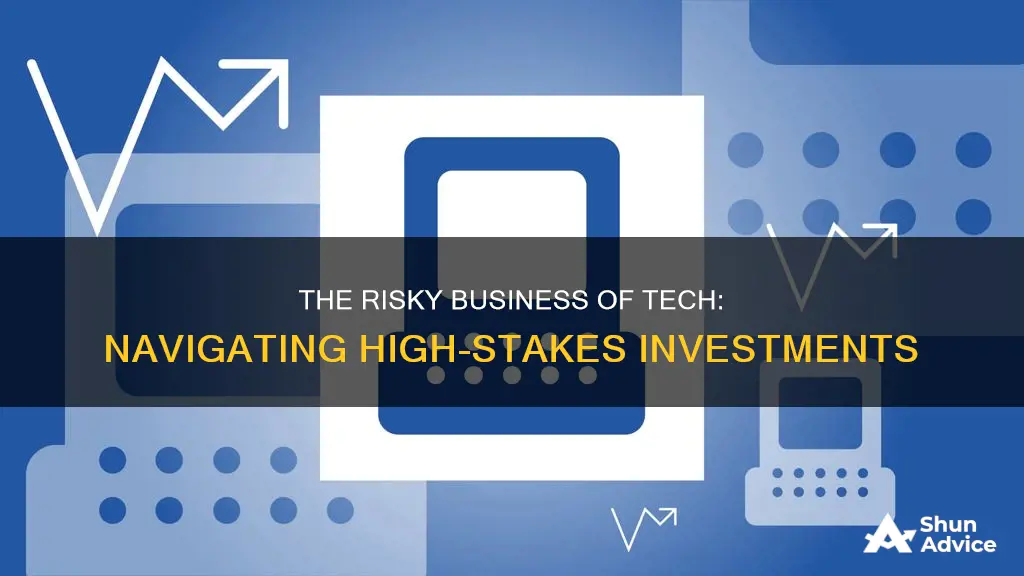
The world of technology investments is fraught with risks that can deter even the most seasoned investors. High-risk investments in technology are often associated with rapid innovation cycles, intense competition, and the ever-present threat of obsolescence. These factors can lead to significant financial losses if not carefully managed. The high-risk nature of technology investments is primarily due to the fast-paced and dynamic nature of the industry. Technological advancements can render products and services obsolete in a short period, making it crucial for investors to stay ahead of the curve and adapt quickly to changing market conditions. Additionally, the intense competition within the tech sector means that companies must continuously innovate and improve their offerings to stay competitive, which can be a significant challenge for investors. This environment often results in high-risk investments, as the potential for success is closely tied to the ability to innovate, adapt, and manage these risks effectively.
What You'll Learn
- Market Volatility: Fluctuations in tech stocks make investments risky
- Regulatory Changes: New laws can impact tech companies' operations and profitability
- Innovation Risks: Rapid tech advancements may render investments obsolete
- Competition: Established firms pose threats to startups' market share
- Customer Adoption: Low adoption rates can hinder tech product success

Market Volatility: Fluctuations in tech stocks make investments risky
The technology sector is renowned for its rapid growth and innovation, but it also presents a unique set of challenges and risks for investors. One of the most significant concerns is market volatility, which can have a profound impact on the performance of technology investments. Market volatility refers to the rapid and unpredictable fluctuations in stock prices, often driven by a variety of factors such as economic conditions, industry trends, and global events. In the tech industry, where companies are often at the forefront of technological advancements, these price swings can be particularly pronounced and risky.
Tech stocks are highly sensitive to market sentiment and external factors. A single piece of news, a product launch, or a change in consumer behavior can trigger a surge or decline in stock prices. For instance, a tech company's share price might skyrocket if a new product is announced, but it can also plummet if the product fails to meet expectations or if a competitor introduces a similar offering. This volatility is further exacerbated by the fact that tech companies often have smaller market capitalizations compared to more established industries, making them more susceptible to price swings.
The nature of the tech industry itself contributes to this risk. Technology is an ever-evolving field, and companies must constantly innovate to stay competitive. This innovation cycle can be unpredictable, and the market's response to new products or services may vary widely. Investors must consider the potential for rapid obsolescence, where a company's current offerings become outdated quickly, leading to a decline in stock value. Additionally, the tech sector is highly competitive, with numerous players vying for market share, which can intensify price fluctuations.
To navigate this volatile environment, investors should adopt a long-term perspective. Short-term market movements can be influenced by various factors, but over time, the underlying fundamentals of a company, such as its financial health, competitive advantage, and growth prospects, tend to stabilize. Conducting thorough research and due diligence is essential to identify companies with strong fundamentals and a history of resilience in the face of market volatility. Diversification is also a key strategy, as spreading investments across multiple tech sectors and companies can help mitigate the impact of any single stock's performance.
In summary, market volatility is a critical aspect of the risks associated with technology investments. The tech industry's dynamic nature, coupled with its sensitivity to market sentiment, makes tech stocks susceptible to rapid price changes. Investors should approach this sector with a cautious yet informed mindset, focusing on long-term strategies, thorough research, and diversification to manage the inherent risks effectively. Understanding and managing market volatility is crucial for anyone looking to invest in the technology space successfully.
Twitch's Bad Investment: What Went Wrong?
You may want to see also

Regulatory Changes: New laws can impact tech companies' operations and profitability
The tech industry is notorious for its rapid evolution and constant innovation, but this dynamic nature also brings a unique set of challenges and risks, especially when it comes to regulatory changes. One of the primary concerns for tech companies is the ever-shifting legal landscape, which can significantly impact their operations and profitability. New laws and regulations often emerge as a response to societal needs, ethical considerations, or the rapid advancements in technology itself. While these changes are intended to provide a framework for responsible development and usage, they can also introduce unforeseen challenges for businesses.
Regulatory changes can affect various aspects of a tech company's operations. For instance, data privacy laws are becoming increasingly stringent worldwide, requiring companies to implement robust data protection measures. This includes obtaining explicit user consent for data collection, ensuring secure data storage, and providing transparent privacy policies. Non-compliance with such regulations can result in hefty fines and legal consequences, especially with the introduction of laws like the General Data Protection Regulation (GDPR) in the European Union, which sets a high standard for data privacy. Tech companies must invest in compliance measures, potentially increasing operational costs and requiring significant resources to adapt their systems.
Another area of concern is intellectual property rights and copyright infringement. As the tech industry thrives on innovation, new laws and treaties are often enacted to protect the rights of creators and inventors. These regulations can impact how tech companies develop and distribute their products, especially in the software and content creation sectors. For instance, stricter copyright laws might require companies to invest more in content moderation and filtering, or even develop new algorithms to identify and prevent copyright violations, all of which can be costly and time-consuming.
Moreover, regulatory changes can influence the overall market dynamics and competition. Tech companies often operate in highly competitive environments, and new laws can create barriers to entry or provide advantages to established players. For example, a government decision to subsidize local tech startups could make it challenging for international companies to compete, especially if the regulations favor local businesses. Such shifts in the market can impact a company's ability to secure funding, attract talent, and maintain its market share, ultimately affecting its profitability.
In summary, regulatory changes are an inherent risk factor in the technology investment landscape. Tech companies must stay agile and proactive in their approach to navigate this complex environment. This includes investing in legal expertise, adapting to new compliance requirements, and understanding the potential impact on their operations and financial performance. By staying informed and prepared, businesses can mitigate the risks associated with regulatory changes and ensure their long-term success in a rapidly evolving industry.
Risk Score Investing: Understanding Your Investment Risk Profile
You may want to see also

Innovation Risks: Rapid tech advancements may render investments obsolete
The rapid pace of technological innovation poses significant risks for investors, as it can quickly render investments obsolete. This phenomenon is particularly prevalent in the technology sector, where new products and services emerge at an astonishing rate. As a result, investors face the challenge of keeping up with the ever-changing landscape to ensure their investments remain viable and profitable.
One of the primary reasons for these high risks is the exponential growth of technology. Innovations in artificial intelligence, automation, and machine learning have revolutionized various industries, leading to increased efficiency and productivity. However, this rapid advancement also means that existing technologies and infrastructure may become outdated in a short period. For instance, the widespread adoption of cloud computing has transformed how data is stored and accessed, rendering traditional on-premises servers less attractive to investors. Similarly, the rise of blockchain technology and cryptocurrencies has disrupted traditional financial systems, challenging the viability of certain investment strategies.
Startups and small businesses often face the brunt of these rapid tech shifts. Early-stage investments in these companies may become risky due to the potential for their core technologies or business models to become obsolete before they can scale. Investors must carefully assess the longevity and adaptability of the technologies these startups are building upon. A successful investment strategy in this environment requires a deep understanding of the industry trends and the ability to identify disruptive technologies that can reshape markets.
To mitigate these risks, investors should adopt a dynamic approach to their portfolios. This includes conducting thorough research to identify emerging trends and disruptive technologies, diversifying investments across different sectors and stages of innovation, and staying agile to adapt to changing market conditions. Additionally, investors can consider investing in companies that focus on innovation and adaptability, ensuring that their investments are not only profitable but also future-proof.
In summary, the high risks associated with technology investments stem from the rapid pace of innovation, which can quickly render existing assets and strategies obsolete. Investors must stay informed, be proactive in their approach, and make strategic decisions to navigate this dynamic landscape successfully. By embracing innovation and adopting a forward-thinking mindset, investors can position themselves to capitalize on emerging opportunities while minimizing potential losses.
Investing in Indian Startups: Pre-IPO Opportunities
You may want to see also

Competition: Established firms pose threats to startups' market share
The technology industry is characterized by intense competition, and this is particularly challenging for startups. Established firms, with their vast resources, market presence, and brand recognition, pose significant threats to the success and market share of young companies. Here's an analysis of this critical aspect:
In the tech sector, competition is fierce, and startups often find themselves in a challenging position. Established companies, having already secured a loyal customer base and market share, can quickly adapt and innovate to stay ahead. For instance, when a startup introduces a groundbreaking product, larger corporations might not be far behind, leveraging their financial power to replicate or improve upon the idea. This rapid response can dilute the startup's unique value proposition and make it harder to gain traction.
One of the primary advantages of being an established player is the ability to invest in research and development (R&D) extensively. These firms can allocate substantial resources to R&D, often resulting in continuous product improvements and the development of cutting-edge technologies. Startups, on the other hand, might struggle to compete in terms of innovation due to limited funding and resources. As a result, they may find themselves playing catch-up, trying to match the features and capabilities of more established brands.
Market presence is another critical factor. Large corporations have already built a strong customer base and brand loyalty. This market presence provides a solid foundation for further growth and expansion. Startups, especially those in their early stages, might struggle to attract customers away from these well-established brands. Customers often prefer the convenience and reliability associated with well-known companies, making it challenging for startups to gain a foothold in the market.
To combat this, startups should focus on identifying and filling gaps in the market that larger firms might have overlooked. They can offer unique solutions, cater to specific niches, or provide personalized experiences that established brands may not be able to match. Additionally, building a strong brand identity and focusing on customer satisfaction can help startups differentiate themselves and build a loyal customer base over time.
In summary, the competition from established firms is a significant challenge for startups in the technology industry. However, by understanding their strengths and weaknesses, startups can develop strategies to navigate this competitive landscape effectively. This might include innovative product development, targeted marketing, and a customer-centric approach to gain a competitive edge.
Savings Glut: When Saving Outpaces Investment
You may want to see also

Customer Adoption: Low adoption rates can hinder tech product success
Low customer adoption rates are a critical challenge for many technology companies, and understanding the reasons behind this can significantly impact the success of your tech product. Here are some key factors to consider:
Understanding the Market and Customers: One of the primary reasons for low adoption is a lack of understanding of the target market and customer needs. Many tech startups rush into the market without thorough market research, assuming that their product will naturally attract customers. However, this approach often leads to a disconnect between the product and the market. Customers may not see the value or relevance of the technology, especially if it doesn't solve a pressing problem or improve an existing process. Conducting comprehensive market research, including surveys, focus groups, and customer interviews, is essential to identify pain points and understand the target audience's preferences and behaviors. This knowledge will enable you to tailor your product and marketing strategies to resonate with potential customers.
Complexity and Usability: Tech products, especially those with innovative features, can be complex and challenging to use. If your product is too technical or requires extensive training, customers may be deterred from adopting it. Users often seek simplicity and ease of use, especially in today's fast-paced digital world. Simplifying the user interface, providing intuitive navigation, and offering comprehensive documentation or tutorials can significantly improve adoption rates. A user-friendly experience not only makes your product more accessible but also encourages customers to explore and utilize all the features, leading to higher satisfaction and loyalty.
Competition and Market Saturation: The technology market is often highly competitive, with numerous alternatives available to customers. If your product doesn't offer a unique value proposition or a significant improvement over existing solutions, it may struggle to gain traction. Customers are more likely to adopt a product that provides a clear advantage, whether it's increased efficiency, cost savings, or enhanced functionality. Differentiating your product and highlighting its unique features and benefits in marketing campaigns can attract customers who are seeking specific solutions. Additionally, staying updated with industry trends and continuously innovating to meet evolving customer needs is crucial for long-term success.
Marketing and Sales Strategies: Effective marketing and sales strategies are vital to driving customer adoption. Many tech companies focus solely on product development, neglecting the importance of marketing and sales. A well-planned marketing strategy should include content creation, social media presence, and targeted advertising to reach the right audience. Building a strong online presence and engaging with potential customers can create awareness and generate interest. Furthermore, a robust sales team that understands the product and its value can effectively communicate the benefits to prospects. Offering incentives, such as free trials or discounts, can also encourage potential customers to try your product and experience its advantages firsthand.
Overcoming Barriers to Adoption: Low adoption rates can be a result of various barriers that customers face. These may include concerns about data security, privacy issues, or the fear of disrupting existing workflows. Addressing these barriers through transparent communication, robust security measures, and demonstrating how your product can streamline processes can build trust and encourage adoption. Additionally, providing excellent customer support and promptly addressing any issues or concerns can significantly impact customer satisfaction and loyalty.
EPS-Driven Investment Decisions: A Guide to Smart Investing
You may want to see also
Frequently asked questions
Technology investments often carry higher risks due to the rapid pace of innovation, market volatility, and the unique challenges associated with disruptive technologies. The frequent emergence of new competitors, changing consumer preferences, and the need for constant adaptation can make these investments more complex and uncertain.
The technology sector is characterized by its dynamic and ever-evolving nature. With constant advancements in hardware, software, and emerging technologies like AI and blockchain, the industry demands a high level of innovation and agility. This rapid evolution can lead to obsolescence, where companies may invest in cutting-edge technology that becomes outdated quickly, posing significant financial risks.
Yes, several factors within the investment lifecycle can contribute to high-risk profiles. These include the high initial costs of research and development, the challenge of accurately predicting market acceptance and demand, and the potential for technological failures or bugs that could impact the product's performance and user experience. Additionally, the time it takes to bring a technology-based product to market can be lengthy, increasing the risk of market shifts during the development phase.
Diversification is a key strategy to manage technology investment risks. Investors can spread their investments across various sectors and sub-sectors within the technology industry to reduce the impact of any single investment's performance. Due diligence is also crucial; investors should conduct thorough research, analyze market trends, and assess the competitive landscape to make informed decisions. Regular monitoring and rebalancing of the investment portfolio can help navigate the volatile nature of the technology sector.
Despite the challenges, technology investments can offer substantial long-term benefits. The technology sector drives innovation, leading to improved efficiency, productivity, and the creation of new markets. Successful technology investments can result in significant financial gains, market dominance, and a competitive edge for companies. However, it is essential to carefully manage risks through strategic planning, robust research, and a well-diversified investment approach.







